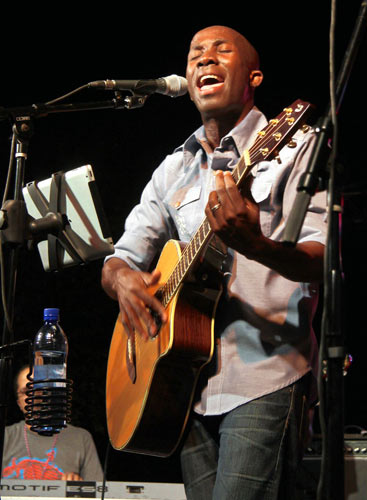Haitian and Haitian-American jazz artists comprised a strong element in the International Jazz Festival of Port-au-Prince 7th Edition that heralded musicians from Brazil, Chile, Spain, Switzerland, France, Belgium, Germany, Holland, Mexico, Canada, and the U.S.
Organized as an eight–day fest accessible to everyone, the Festival featured six free open-air early-evening concerts, each with three groups performing.
More than 325 music enthusiasts including many students –a stand-room crowd– enjoyed these mostly at the “downtown” Port-au-Prince FOKAL cultural center.
Additionally, there were four ticketed upscale shows attended by diplomats, sponsors and local Haitian residents.
Heading the festival, the Branford Marsalis Quartet played a free performance in Jacmel, a ticketed concert in Port-au-Prince and a special invite show at the U.S. Ambassador’s residence.
Petionville’s Quartier Latin and Garden Studio music clubs were the site of many of the scheduled “Afterhours” performances.
Following those, musicians and locals mixed it up with jam sessions playing far into the night. And things got hot, fueled by the abundance of talent.
An enthusiastic audience of Haitians and foreigners, imbibing the local Barbancourt rum and Prestige beer, listened to grooving musician friends creating melodic and rhythmic explosions on the stage.
High-energy Mexican guitarist and Bushwick resident Ilan Bar-Lavi and his band Los Sonox (playing the musical genre Son Jarocho mixed with other styles) jammed with Cuban piano virtuoso, Washington Heights resident Axle Laugart, a member of singer Melanie Charles’ band, “The Journey.” Even downpours didn’t halt the “Afterhours” shows.
Alternately, when the main concerts took place in Petionville, Yanvalou restaurant/gallery that had just opened weeks before in Pacot, Port-au-Prince, hosted more than one night’s rendezvous.
Eleven partnering foreign embassies underwrote the costs of their respective musicians, who also often gave special invite performances. The Ministries of Culture and Tourism trimmed some financial support due to the impact of recent Hurricane Sandy.
During jazz week, Festival musicians also gave morning music workshops–9:00 a.m. and 11:00 a.m.– at FOKAL: performing, demonstrating techniques, and dialoguing with Haitian music students (ages, late teens to twenties). Many of the attending students came from church music traditions. After all, the churches in Haiti often nurture music performance–it’s a part of the service. Those present at the workshops clearly were not solely embedded in this genre.
The teaching artists would usually start by playing a couple numbers. Local guitarist Claude Carre, who translated the words of English-speaking musicians into Kreyol, recognized how valuable it was for the students to listen close-up to many different types of music within the jazz genre. They were also given the opportunity to ask an unlimited number of questions.
At one workshop, the Chilean string players Sagere Trio including a mandolin explained that their music came from a folk tradition in the north of Chile. They answered very specific questions related to technique: why do you use your nail and not a pick (a softer sound) followed by demonstrations of alternate and sweep picking. They fielded questions about harmony and arranging.
Louis Winsberg’s workshop included a demonstration of Flamenco dance.
In a packed auditorium, Brooklyn’s own Melanie Charles backed by her musicians moved the handful of attending females to the front row when she gave a voice lesson to eager students.
Following the formal presentation, students gravitated to musicians playing their own instrument of study, flooding them with questions of technique. Drummer Gashford Guillaume and singer Charles loved the eager interaction with the students.
The Festival also screened three music related films including Spike Lee’s Mo Better Blues at a nearby venue.
The Jazz Festival has come a long way since its early editions when the three founders, including drummer and sound engineer Joel Widmeir, physically moved the sound speakers at the downtown Champs Mars venue and were hands-on with stage set-up. Now, a vast team of staff, partners, volunteers and the invaluable Milena Sandler–married to Widmeir–are instrumental in the Festival’s smooth running, all under the umbrella of Fondation Jazz Haiti.
Cancelled the year of the earthquake, the Festival’s continuation celebrates Haitians’ love of music, healing as much as it entertains.
In another example of the broad reach of the Festival, two Swiss volunteer sound specialists conducted two weeks of technical workshops prior to the Festival for Haitian sound technicians and worked side by side with them doing the Festival’s sound.
This year, eight commercial partners, 11 foreign embassies, numerous Haitian and foreign cultural institutions, and the European Union were among supporting partners.
Former Minister Marie-Laurent Jocelyn Lassegue was in the audience closing night at the historic Canne a Sucre park, which featured renowned singer and bass player Cameroonian Richard Bona and the Afro-Cuban band Mandekan Cubano. Brooklyn jazz singer Melanie Charles also helped closeout the Festival.
The former Minister of Culture and Communication said, “Before the Festival began in 2006, jazz in Haiti was for a small part of the population–the bourgeoisie and intellectuals. Now, thanks to the Festival, more people have the possibility to learn, understand, and appreciate this music. It’s not only now for the musicians but for population in general, especially the free shows.”
Marie-Laurent commented on how the Festival continues to be better organized and that there are more local sponsors on-board, not just international organizations.
“It’s a success!” commented the former minister, acknowledging the immense undertaking it is to put the Festival together. She said, “It takes one year to prepare it! After a short break, they’ll start to prepare for next year.”

Axle Laungart, keyboard with Melanie Charles’ The Journey, demonstrates his technique following the formal part of the Charles’ voice workshop.
Photo by Tequila Minsky



























